


Greetings!
Three notes to start before we get to the good stuff.
1. I legitimately don’t think I’ve ever received as much feedback for anything I’ve ever done as I received on that ridiculous Wordle puzzle we put out last Saturday. Nothing about the Masters, the Ryder Cup, none of it. Nandina as a Wordle word, though? So many emails.
2. On that note, I think I’ve arrived at a place in this business where I will still respond as much as possible to emails, but the days of responding to every single one I receive are probably over. That has been a point of pride for me over the years, but it has probably started taking away from my other responsibilities. So … genuinely … it’s not you, it’s me. I love, love, love hearing from all of you, and if I don’t respond it doesn’t mean I didn’t want to and it definitely doesn’t mean I didn’t see what you wrote.
3. Black Friday. We are planning two things next week. The first is 30 percent off to the pro shop for members. The second is 50 (first time) Normal Club membership spots for $50 each (normally $82). We’ll do this type of membership sale once or twice a year as we build up our club so if you’ve been thinking about joining the Normal Club or purchasing some gear, next week would be a great time to do both.
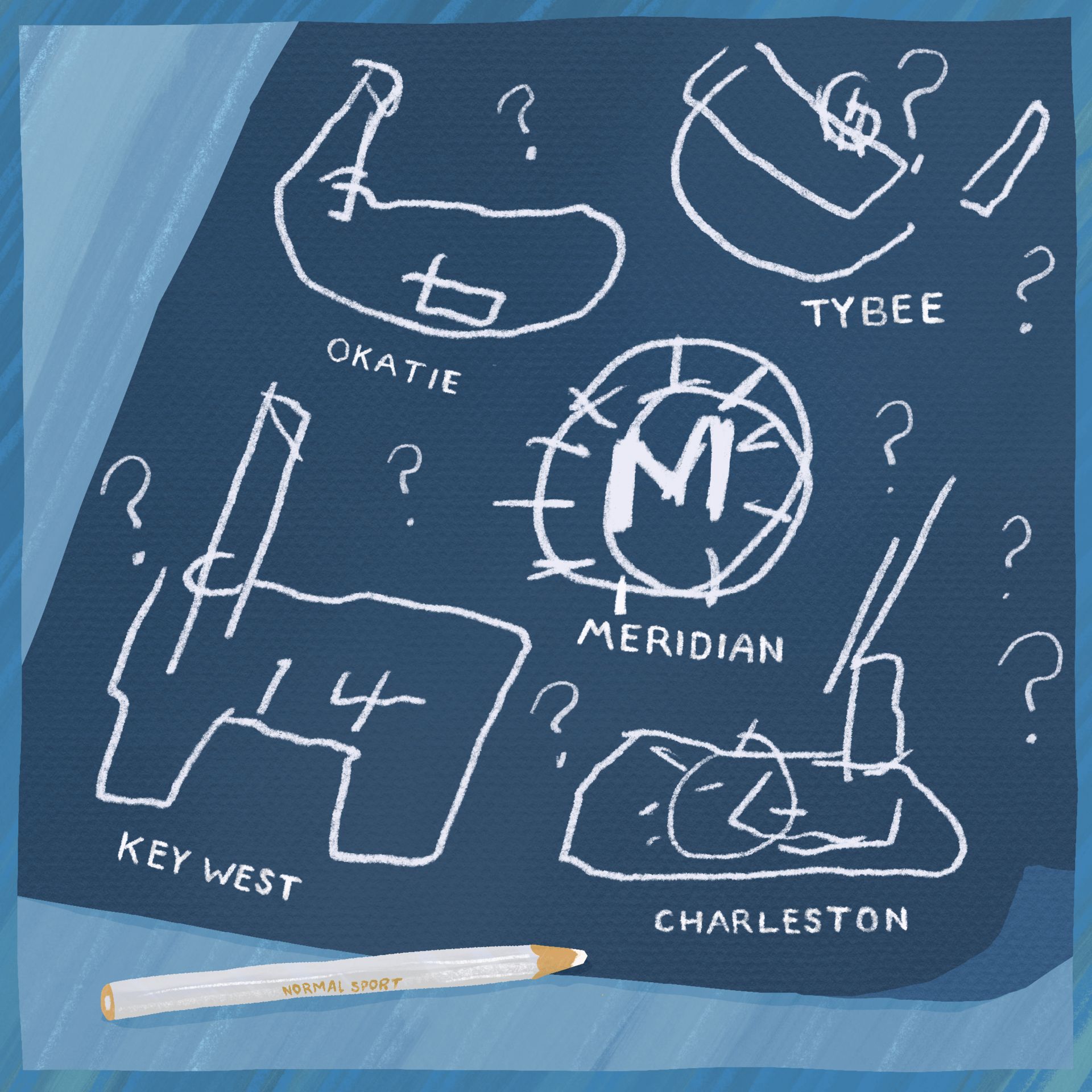
Jason’s Meridian blind draw.
Today’s thoughts are sponsored by Meridian Putters, which is hosting their annual blind draw sale, where you select from one of eight Meridian putter models and get an insanely good putter in that category for a ridiculous price (up to 50 percent off).
These putters are gently used as demos at shows and events and the face finish is completely random. But each one is inspected by a Meridian employee and [whispers] they’re basically new.
I have personally already bought my blind draw putter right here, and you should check it out if you’ve been interested at all in a Meridian putter.
Here’s what I went with.

This blind draw sale has limited availability and will sell out quickly so don’t wait around.
Get involved!
Additionally, Meridian is dropping their crazy Black Friday sale starting next Wednesday, Nov. 26. We will remind you of this, but all brand new in-stock putters will be 35 percent off, which is — by far — their best deal of the entire year.
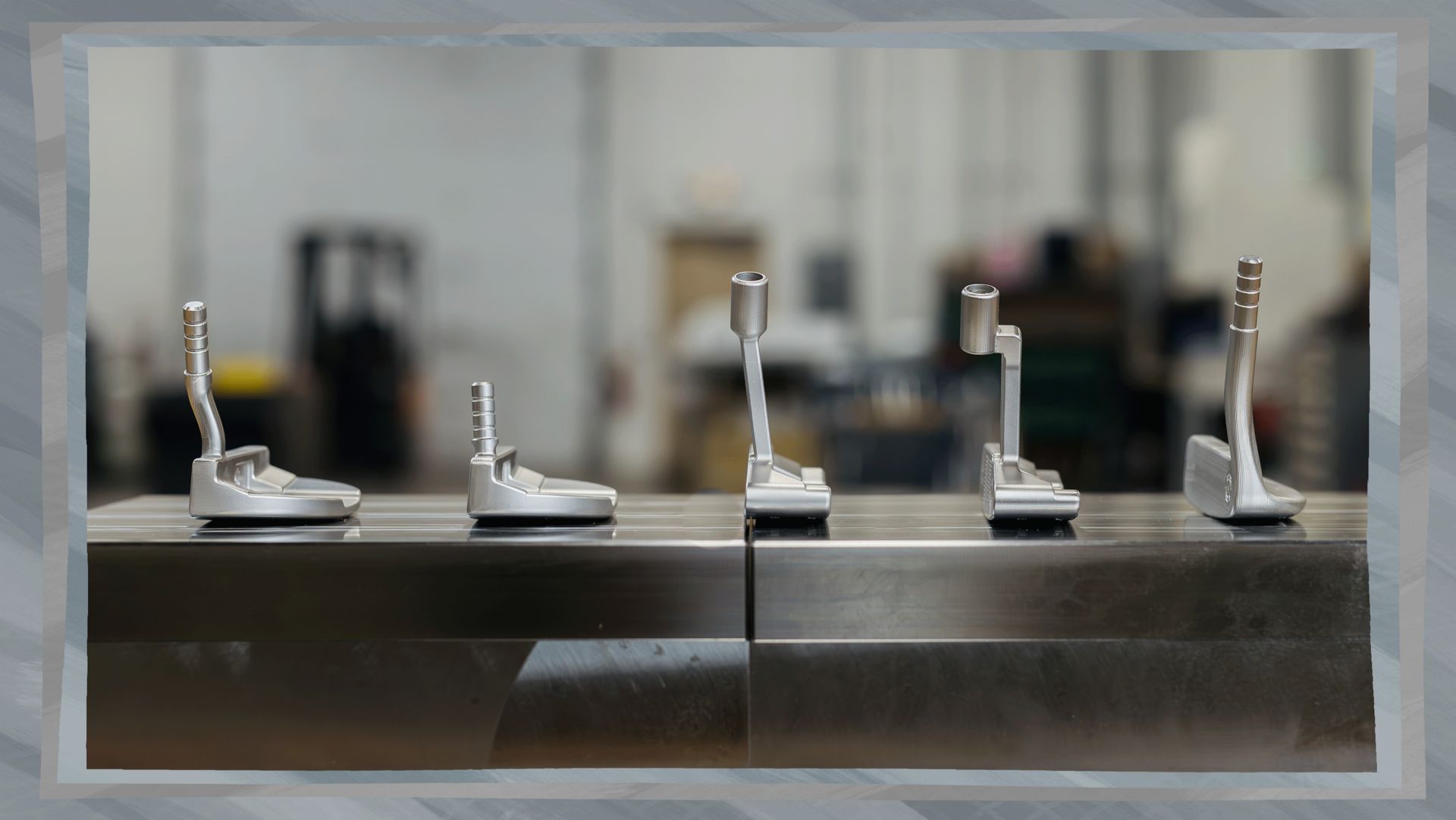
More on that coming early next week!
OK, now onto the news.
1. Last week I clicked on an article by my friend Dylan over at Golf.com about the Internet Invitational (more on that event below). And I was met with a ludicrous number of advertisements.
So many ads that it became difficult to discern whether I was supposed to be there for the text I ostensibly clicked through to read or the ads that greeted me when I arrived.
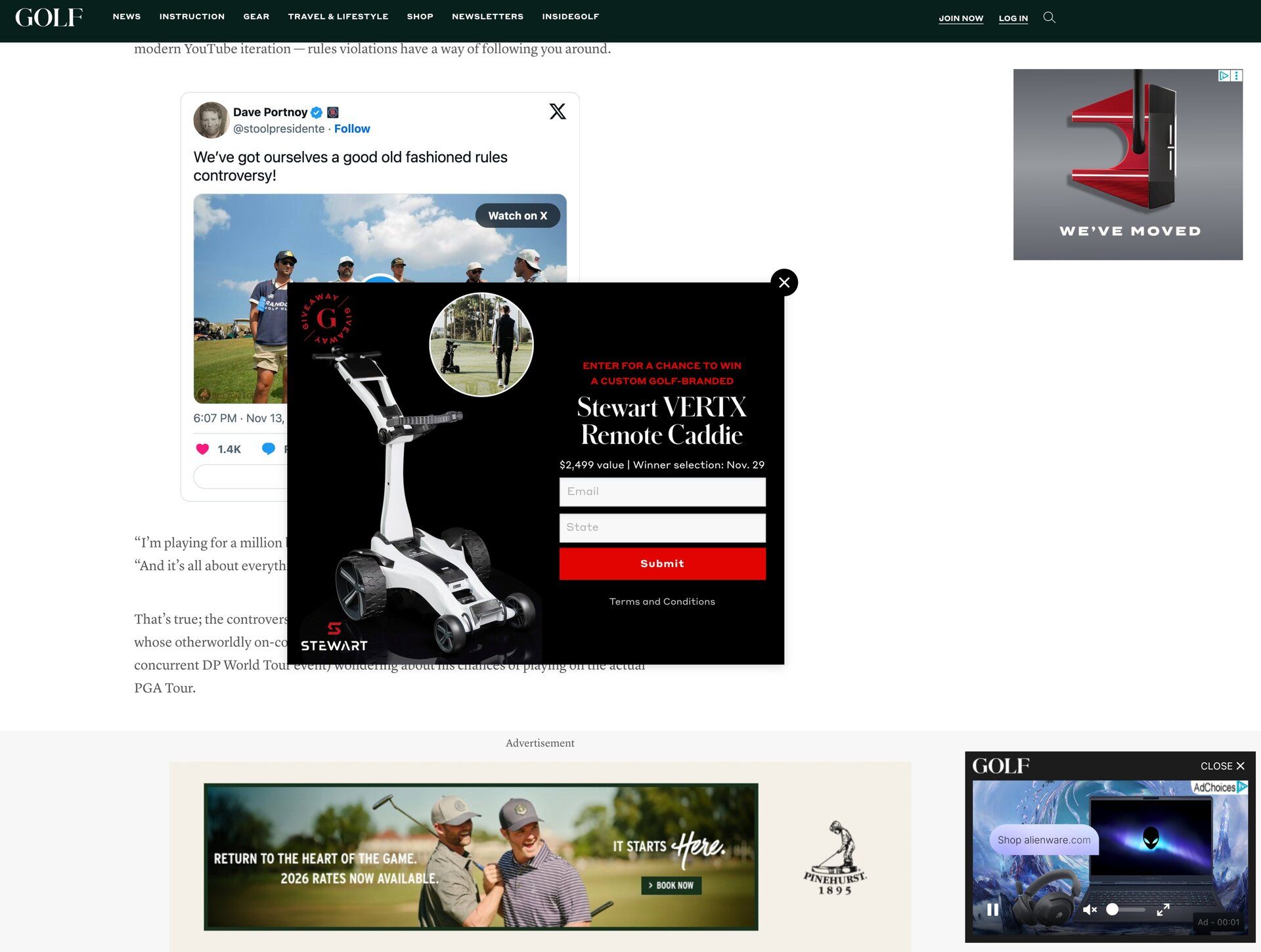
Programatic ads like this are nothing new to the internet, and I am no stranger to them myself. In a former career, I ran an Oklahoma State website that leaned heavily on programatic advertising to generate revenue.
I … sort of regret that, but for a tiny shop like we were, it was difficult to be content creators in addition to ad curators/salespeople so it was much easier to simply lean on these types of ads, many of which can be thrown on any website by any organization. In other words, there’s not a lot of thought that goes into them.
2. This is not an anti-Golf.com take. This is happening everywhere. ESPN.com, the NYT (albeit not always as aggressively) and even my old employer, CBS Sports. I understand the model. Congregate tons of people for long periods of time, profit off their attention.
This is not that different than what the TV model has looked like over the years.
However, when the barrier to entry of content creation online is so low, it means that the number of consumers and the number of producers is basically the same. This is not true in, say, TV. The number of consumers far outweighs the number of producers.
In other words, everyone who consumes things online can also (and often does also) create them.
Because of this reality of the internet, it’s easy to see how attention starts getting more and more and more divided up across all these platforms and sites. And places that were accustomed to making X dollars with Y ads under their previous business model, now have to produce 5Y ads to make X dollars.
This is, as you can see, a problem.
3. Now the self-serving part. Part of the bet we’ve been making with Normal Sport is that many of these other places and their ads will be such a turn-off to readers and consumers that they will sprint with all the ferocity of Abe Ancer and Adam Scott trying to beat the horn, to media outlets that treat them more like humans.
To be clear, this is difficult.
It requires the following.
Good relationships with terrific sponsors.
Whose products we actually like and don’t just shill.
Trust from those sponsors to present their products in a compelling way.
Time to think through how to do No. 3.
We have gotten better at this on the newsletter side (we are still working at it on the podcasting side) and for 2026 we are committed to one presenting sponsor and one ad per newsletter.
The magic here is when the ads are part of the content, and that’s where Jason shines.
Content as advertising, like the Ryder Cup trophy going through TSA in OGIO's new Renegade Vault carry on bag? That's an ad, but it's barely one. It took us many, many hours (one Bethpage to Amsterdam flight to be precise) to make this and to put it in the right spot at the right time.

And to be clear, this is likely less lucrative and certainly more work than it would be if we just piled as many programatic ads as possible into the system. But it is also more considerate of the ultimate customer … you! And it also serves the brand (OGIO or whoever) way better than the mindlessness of these programatic ads. And we love the challenge of telling stories in new ways with our skill sets.
Ads can be good, but bad ads are so bad (and most online ads are bad). Most online ads are just a shell game of money changing hands where everyone is pretending like the reader is benefitting but everyone definitely knows that he or she is not.
4. Will this work for us? I don’t know! I hope so! It’s a bet we’re making. But it’s not the only bet we’re making. We’re also betting on membership and products (Rory book!) and merchandise. All moving parts of the whole business.
Perhaps this bores you. It is fascinating to me, and I like writing about things that fascinate me because I know as a consumer I am attracted to people who are fascinated with things. Obsessives.
I realize none of this is really about golf, but I would also say that this newsletter is only sometimes actually about golf. Golf is definitely the prism through which I see so much of the world, but it is rarely the ultimate thing I am fixated upon.
5. In our most recent podcast, Luke Kerr-Dineen and I talked about stats that aren’t stats but definitely should be. One of LKD's is what he calls power percentage, or the percentage of max speed a player hits on specific drives.
I like it, and it should definitely be a stat.
And of course, JRay went and found the players who — radar misreads aside — seemed to be taking the most off their drives in 2025.
No. 1 surprised me.
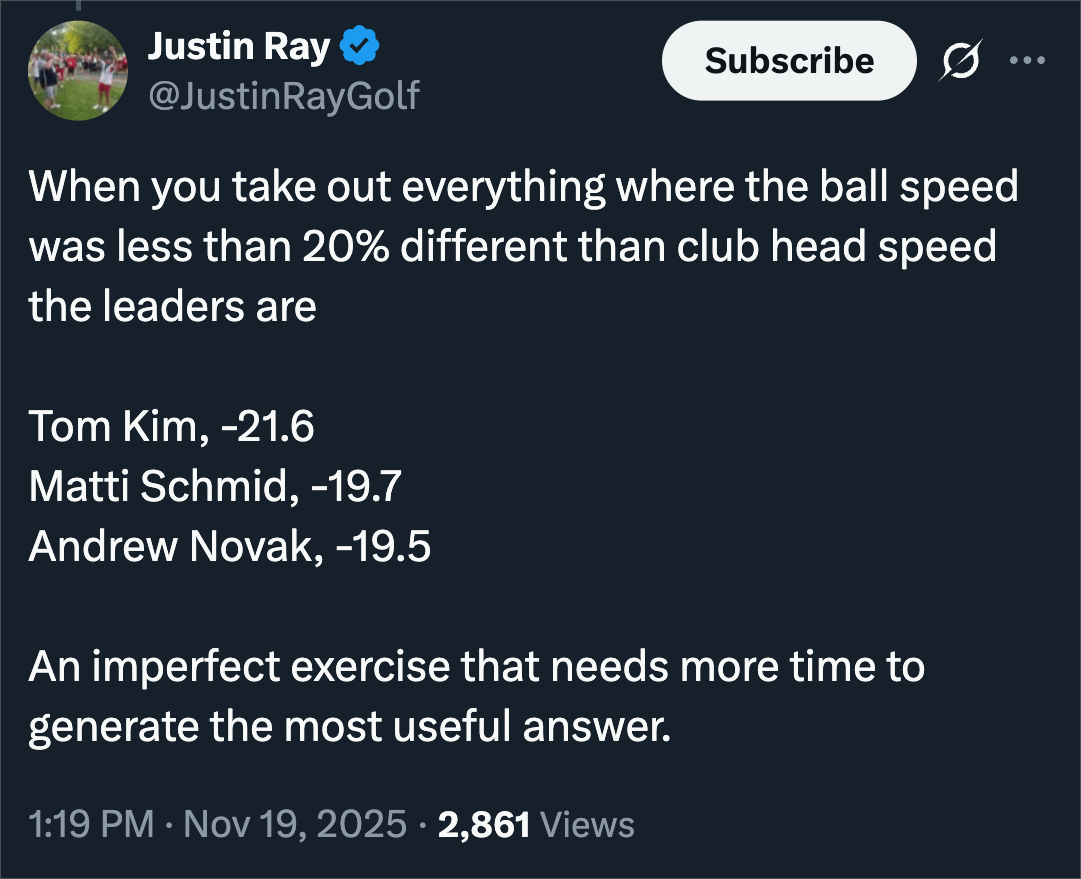
The point here is that golf could use some creativity in its statistics to help provide context for viewers and also to help us solve the, “Well I just feel like things are this way” problems that often arise.
This post will continue below for Normal Club members and includes some thoughts on the Internet Invitational and Harris English’s comments on the PGA Tour schedule.
Welcome to the members-only portion of today’s newsletter.
We are grateful for your support and always thinking about how to bring more and more value to you for your annual membership fee.
6. Unlike the rest of team Normal Sport and 2.9 million(!) golf fans, I still haven’t watched more than five minutes of the Internet Invitational, and yet … I have some takes. On Tuesday, I wrote about how the Internet Invitational bears out one of my predictions from earlier this year, that men’s pro golf is ripe for disruption from an entertainment standpoint. This is not a novel theory, and I am not even close to the first (or only) person to posit it.
However, Shane Ryan’s Digest piece from this week got me thinking more about it. The article is about how the tournament was about fathers and sons, which is a golf trope as old as golf itself.
But the subtext was this: The Internet Invitational has real characters. Whether they are ginned up or not matters very little.
This seems like just the beginning, too. Portnoy announced on Thursday that Caitlin Clark and Kai Trump are on board for 2026, and it’s easy to see where all of this is headed.
One-off golf content creators can and do attract attention on their own channels, but a unifying organizer like Portnoy/Barstool makes the whole thing insanely powerful.
A question: Are you more likely to watch the Honda Classic in 2026 or the Internet Invitational?
Twitter tweet
7. I don’t know that this is necessarily a problem for the PGA Tour because even as sponsorship money floods the market elsewhere, there is always going to be demand by companies who want to cozy up to the glitz and glamour of leagues like the PGA Tour — not to mention the corporate benefits from doing so.
However, I’m curious if the eyeballs will continue to be there. This past season — a shockingly good one for the Tour in terms of ratings — suggests that they will be.
But, as I have noted many times now, a league that just got a 10-figure investment from private equity and that has enjoyed an up-and-to-the-right revenue stream for the last quarter century is now facing the two-fold challenge of Tiger’s exit and the rise of YouTube golf. Both of which will divert a lot of attention and a lot of eyeballs in the future.
The question for me is not whether the Tour will continue to find sponsorship because it for sure will. The question is whether there will be enough attention and attendance at these events to warrant the continually increasing purses everyone at the Tour wants to see.
8. Somewhat related: Here is a question I posed on next week’s podcast with James Colgan. Would you rather own the media rights to …
At first glance, this seems like an absolutely ridiculous question. But in terms of revenue flowing in?
Might be a different story.
9. To wrap all of this up, I thought Harris English’s comments at the RSM were pretty fascinating.
I think that's what they're going to change down the road maybe in 2027 is have all the tournaments be equal and not have the eight elevated events and the regular events. They'll have 20, 22 events that are all the same. I think that's a good model to have. That's where you'll see all the top players play every single event because you can't really afford to take one off.
We'll see where it goes. I think they'll more go where 20 events are all the same, all the points, all the money, everything the same.
Harris English
Me reading that.

As KVV and JLM pointed out, this may or may not be something. Details are scant, and I’m sure many conversations still need to take place. However, a crazy reduction in the available schedule for top players (from ~45 to 20) is a good move and would be a follow through from Brian Rolapp after his speech that scarcity is a value for the Tour.
That has definitively not been the case throughout its history, but it would be a much needed change in this modern iteration of the league.
My (probably pipe dream) desire for all of this is that they rotate the locations around so that the same places don’t get tournaments every year. Do a golf course reveal like Fried Egg did with their 2026 event rota yesterday. Get players on a live stream making jokes about executives and each other. Need it.
We’ll see where all of this goes, but to me, even this information is an encouraging sign that Rolapp and Co. are thinking outside the box and not confined to how things have been done under past regimes.
If you ever want to support our business, you can buy some Norman merch here (at a discount!) or pass along our site to your golf group chat and get them involved in all this nonsense as well.

Greetings!
Three notes to start before we get to the good stuff.
1. I legitimately don’t think I’ve ever received as much feedback for anything I’ve ever done as I received on that ridiculous Wordle puzzle we put out last Saturday. Nothing about the Masters, the Ryder Cup, none of it. Nandina as a Wordle word, though? So many emails.
2. On that note, I think I’ve arrived at a place in this business where I will still respond as much as possible to emails, but the days of responding to every single one I receive are probably over. That has been a point of pride for me over the years, but it has probably started taking away from my other responsibilities. So … genuinely … it’s not you, it’s me. I love, love, love hearing from all of you, and if I don’t respond it doesn’t mean I didn’t want to and it definitely doesn’t mean I didn’t see what you wrote.
3. Black Friday. We are planning two things next week. The first is 30 percent off to the pro shop for members. The second is 50 (first time) Normal Club membership spots for $50 each (normally $82). We’ll do this type of membership sale once or twice a year as we build up our club so if you’ve been thinking about joining the Normal Club or purchasing some gear, next week would be a great time to do both.

Jason’s Meridian blind draw.
Today’s thoughts are sponsored by Meridian Putters, which is hosting their annual blind draw sale, where you select from one of eight Meridian putter models and get an insanely good putter in that category for a ridiculous price (up to 50 percent off).
These putters are gently used as demos at shows and events and the face finish is completely random. But each one is inspected by a Meridian employee and [whispers] they’re basically new.
I have personally already bought my blind draw putter right here, and you should check it out if you’ve been interested at all in a Meridian putter.
Here’s what I went with.

This blind draw sale has limited availability and will sell out quickly so don’t wait around.
Get involved!
Additionally, Meridian is dropping their crazy Black Friday sale starting next Wednesday, Nov. 26. We will remind you of this, but all brand new in-stock putters will be 35 percent off, which is — by far — their best deal of the entire year.

More on that coming early next week!
OK, now onto the news.
1. Last week I clicked on an article by my friend Dylan over at Golf.com about the Internet Invitational (more on that event below). And I was met with a ludicrous number of advertisements.
So many ads that it became difficult to discern whether I was supposed to be there for the text I ostensibly clicked through to read or the ads that greeted me when I arrived.

Programatic ads like this are nothing new to the internet, and I am no stranger to them myself. In a former career, I ran an Oklahoma State website that leaned heavily on programatic advertising to generate revenue.
I … sort of regret that, but for a tiny shop like we were, it was difficult to be content creators in addition to ad curators/salespeople so it was much easier to simply lean on these types of ads, many of which can be thrown on any website by any organization. In other words, there’s not a lot of thought that goes into them.
2. This is not an anti-Golf.com take. This is happening everywhere. ESPN.com, the NYT (albeit not always as aggressively) and even my old employer, CBS Sports. I understand the model. Congregate tons of people for long periods of time, profit off their attention.
This is not that different than what the TV model has looked like over the years.
However, when the barrier to entry of content creation online is so low, it means that the number of consumers and the number of producers is basically the same. This is not true in, say, TV. The number of consumers far outweighs the number of producers.
In other words, everyone who consumes things online can also (and often does also) create them.
Because of this reality of the internet, it’s easy to see how attention starts getting more and more and more divided up across all these platforms and sites. And places that were accustomed to making X dollars with Y ads under their previous business model, now have to produce 5Y ads to make X dollars.
This is, as you can see, a problem.
3. Now the self-serving part. Part of the bet we’ve been making with Normal Sport is that many of these other places and their ads will be such a turn-off to readers and consumers that they will sprint with all the ferocity of Abe Ancer and Adam Scott trying to beat the horn, to media outlets that treat them more like humans.
To be clear, this is difficult.
It requires the following.
Good relationships with terrific sponsors.
Whose products we actually like and don’t just shill.
Trust from those sponsors to present their products in a compelling way.
Time to think through how to do No. 3.
We have gotten better at this on the newsletter side (we are still working at it on the podcasting side) and for 2026 we are committed to one presenting sponsor and one ad per newsletter.
The magic here is when the ads are part of the content, and that’s where Jason shines.
Content as advertising, like the Ryder Cup trophy going through TSA in OGIO's new Renegade Vault carry on bag? That's an ad, but it's barely one. It took us many, many hours (one Bethpage to Amsterdam flight to be precise) to make this and to put it in the right spot at the right time.

And to be clear, this is likely less lucrative and certainly more work than it would be if we just piled as many programatic ads as possible into the system. But it is also more considerate of the ultimate customer … you! And it also serves the brand (OGIO or whoever) way better than the mindlessness of these programatic ads. And we love the challenge of telling stories in new ways with our skill sets.
Ads can be good, but bad ads are so bad (and most online ads are bad). Most online ads are just a shell game of money changing hands where everyone is pretending like the reader is benefitting but everyone definitely knows that he or she is not.
4. Will this work for us? I don’t know! I hope so! It’s a bet we’re making. But it’s not the only bet we’re making. We’re also betting on membership and products (Rory book!) and merchandise. All moving parts of the whole business.
Perhaps this bores you. It is fascinating to me, and I like writing about things that fascinate me because I know as a consumer I am attracted to people who are fascinated with things. Obsessives.
I realize none of this is really about golf, but I would also say that this newsletter is only sometimes actually about golf. Golf is definitely the prism through which I see so much of the world, but it is rarely the ultimate thing I am fixated upon.
5. In our most recent podcast, Luke Kerr-Dineen and I talked about stats that aren’t stats but definitely should be. One of LKD's is what he calls power percentage, or the percentage of max speed a player hits on specific drives.
I like it, and it should definitely be a stat.
And of course, JRay went and found the players who — radar misreads aside — seemed to be taking the most off their drives in 2025.
No. 1 surprised me.

The point here is that golf could use some creativity in its statistics to help provide context for viewers and also to help us solve the, “Well I just feel like things are this way” problems that often arise.
This post will continue below for Normal Club members and includes some thoughts on the Internet Invitational and Harris English’s comments on the PGA Tour schedule.
Normal Sport is supported by exactly 1,012 crazed individuals. By becoming a member, you will receive the following …
• A vote for trusted, independent media.
• The delight of helping us establish Normal Sport.
• 15% off to our pro shop (and more in the upcoming weeks!).
• Access to all of our content (like the rest of this post).
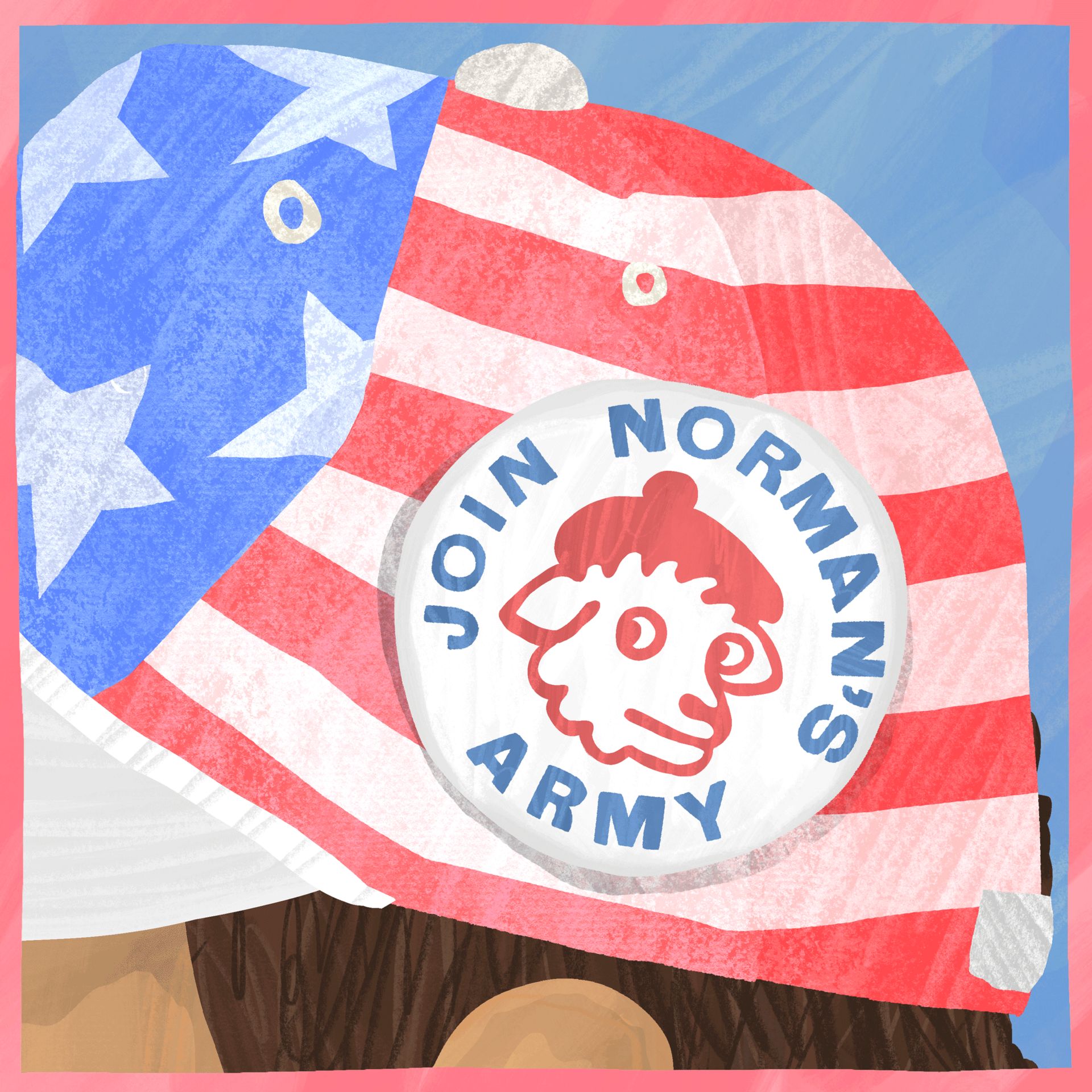










.svg)